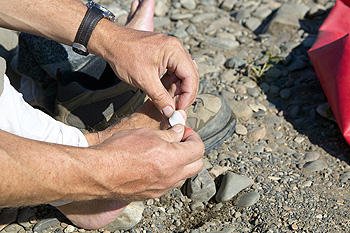
Blisters from hiking are common and can turn a great trek into a painful experience. They form when repeated friction, heat, and moisture irritate the skin, causing fluid-filled bubbles to develop. The metatarsal heads, which are the rounded ends of the long bones in the ball of the foot, are particularly prone to blisters due to pressure and movement during hiking. Surprisingly, the number of blisters does not reflect foot functionality or fitness in hikers. Even seasoned hikers with strong feet can experience blisters if conditions like improper footwear or prolonged moisture arise. Prevent blisters by wearing well-fitted boots, moisture-wicking socks, and applying blister prevention products. If a blister forms, clean and protect it to avoid infection. If you have persistent or painful blisters it is suggested that you seek professional care from a podiatrist who can provide tailored advice to keep your hiking adventures on track.
Sports related foot and ankle injuries require proper treatment before players can go back to their regular routines. For more information, contact one of our podiatrists of Ankle and Foot Centers of Missouri, P.C.. Our doctors can provide the care you need to keep you pain-free and on your feet.
Sports Related Foot and Ankle Injuries
Foot and ankle injuries are a common occurrence when it comes to athletes of any sport. While many athletes dismiss the initial aches and pains, the truth is that ignoring potential foot and ankle injuries can lead to serious problems. As athletes continue to place pressure and strain the area further, a mild injury can turn into something as serious as a rupture and may lead to a permanent disability. There are many factors that contribute to sports related foot and ankle injuries, which include failure to warm up properly, not providing support or wearing bad footwear. Common injuries and conditions athletes face, including:
- Plantar Fasciitis
- Plantar Fasciosis
- Achilles Tendinitis
- Achilles Tendon Rupture
- Ankle Sprains
Sports related injuries are commonly treated using the RICE method. This includes rest, applying ice to the injured area, compression and elevating the ankle. More serious sprains and injuries may require surgery, which could include arthroscopic and reconstructive surgery. Rehabilitation and therapy may also be required in order to get any recovering athlete to become fully functional again. Any unusual aches and pains an athlete sustains must be evaluated by a licensed, reputable medical professional.
If you have any questions please feel free to contact our offices located in the Greater Kansas City area . We offer the newest diagnostic and treatment technologies for all your foot and ankle needs.
